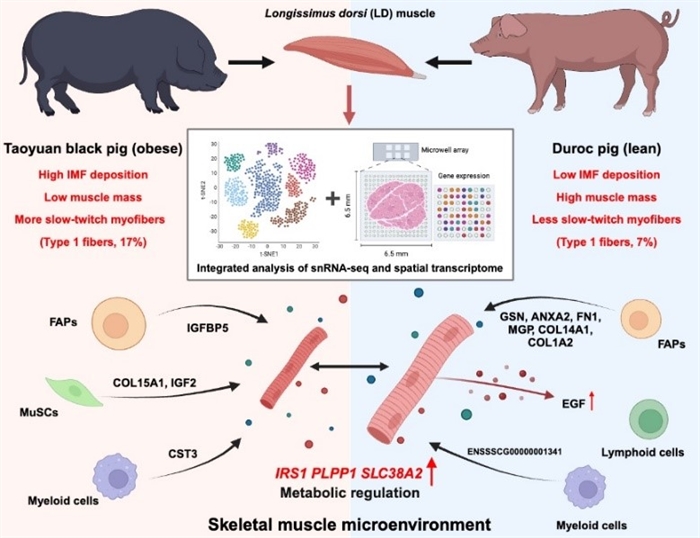
A new study, led by Prof. YIN Yulong from the Institute of Subtropical Agriculture of the Chinese Academy of Sciences, reveals crucial insights into the metabolic regulation of skeletal muscle through cellular interactions.
Published in Journal of Cachexia, Sarcopenia and Muscle on March 13, the study uncovers significant differences in gene expression profiles between Taoyuan black (TB, obese, native Chinese breed) and Duroc (lean) pigs at 180 days, with a focus on the longissimus dorsi (LD) muscle. The study highlights the cellular heterogeneity and spatial specificity within muscle tissue, offering new perspectives on metabolic regulation in both pigs and humans.
Using integrated snRNA-seq and spatial transcriptome analysis, the researchers identified key secretory genes that could serve as diagnostic and intervention targets for metabolic diseases and meat quality in pigs.
Producing high-quality pork products has become a critical objective for the high-quality development of the pig farming industry, and meat quality is mainly affected by intramuscular fat (IMF) content and myofiber type composition. Muscle and adipose tissues, two important metabolic and secretory organs, communicate with each other through secretory factors, also known as the "muscle-adipose axis". Cell–cell crosstalk between myogenic, adipogenic and immune cells in skeletal muscle to regulate energy metabolism and lipid deposition has received considerable attention. The specific mechanisms of interaction between the different cells in skeletal muscle are still unclear.
The researchers investigated this interaction by studying obese Taoyuan black pigs and lean Duroc pigs. Their innovative approach integrated snRNA-seq and spatial transcriptome analysis to reveal the close communication between adipogenic and myogenic cells in porcine LD muscle.
They confirmed that Fibro/Adipogenic progenitors (FAPs) are a key source of secretory proteins in skeletal muscle, playing a significant role in intercellular communication. These secretory proteins help regulate muscle fiber type composition and muscle metabolism.
The molecular mechanism of the skeletal muscle microenvironment constructed by secretory proteins to regulate muscle fiber type composition and muscle metabolism pattern was clarified, and several key myokines and adipokines involved in muscle-adipose interaction were identified.
"These finding not only provide a theoretical foundation and potential target for the nutritional regulation and genetic breeding of pork quality, but also bring inspiration for the study of human obesity and metabolic diseases using pig models," said Prof. LI Fengna, corresponding author of the study.

Mechanism of muscle-adipose interaction in porcine skeletal muscle microenvironment (Imaged by GUO Liu)

86-10-68597521 (day)
86-10-68597289 (night)

52 Sanlihe Rd., Xicheng District,
Beijing, China (100864)

